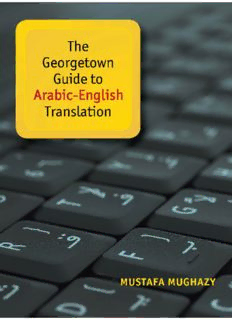
The Georgetown Guide to Arabic-English Translation PDF
Preview The Georgetown Guide to Arabic-English Translation
The Georgetown Guide to Arabic–English Translation This page intentionally left blank The Georgetown Guide to Arabic–English Translation MUSTAFA MUGHAZY Georgetown University Press / Washington, DC © 2016 Georgetown University Press. All rights reserved. No part of this book may be reproduced or utilized in any form or by any means, electronic or mechanical, including photocopying and recording, or by any information storage and retrieval system, without permission in writing from the publisher. Library of Congress Cataloging-in-Publication Data Mughazy, Mustafa, 1974– author. The Georgetown manual of Arabic-English translation / Mustafa Mughazy. pages cm Includes bibliographical references and index. ISBN 978-1-62616-292-1 (hardcover : alk. paper) — ISBN 978-1-62616-279-2 (pbk. : alk. paper) — ISBN 978-1-62616-280-8 (ebook) 1.Arabic language—Translating into English. 2. Translating and interpreting—Philosophy. I. Title. PJ6403.M84 2016 428’.02927—dc23 2015022046 ∞ This book is printed on acid-free paper meeting the requirements of the American National Standard for Permanence in Paper for Printed Library Materials. 17 16 9 8 7 6 5 4 3 2 First printing Cover design by Beth Schlennoff Printed in the United States of America In memory of Dr. Souad Hussein Sobhy This page intentionally left blank __________________________ Contents Acknowledgments xi Introduction: Who Needs a Manual for Arabic–English Translation Anyway? 1 1 G etting Words Across: Word- Level Translation Problems and Strategies 9 1 Word-Level Translation Problems 11 1.1 Lexical Gaps 11 1.2 False Equivalents 14 1.3 Borrowings 19 1.4 Word Frequency 20 1.5 Ambiguity 22 1.6 Semantic Complexity 24 2 Translation Strategies 26 2.1 Translation by Deletion 26 2.2 Translation by Substitution 30 2.3 Translation by Morphological Unpacking 36 2.4 Translation by Paraphrasing 38 2.5 Translation by Transliteration 40 Exercises 43 2 P utting Words Together: Phrase- Level Translation Problems and Strategies 47 1 Translation Problems 48 1.1 Structural Mismatches 48 1.2 Functional Mismatches 50 1.3 Structural Ambiguity 54 viii Contents 2 Noncompositional Meaning 56 2.1 Frozen Expressions 57 2.2 Collocations 59 2.3 Phrasal Compounds 63 2.4 Idioms 65 3 Translation Strategies 70 3.1 Morphological Packaging 70 3.2 Phrasal Reconstruction 73 3.3 Translation by Deletion 77 3.4 Literalization 83 3.5 Metaphorical Approximation 85 3.6 Metaphorization 87 Exercises 88 3 Inside the Sentence: Functional Categories 93 1 Temporal Reference 93 1.1 The Simple Aspects 94 1.2 Complex Aspects 103 1.3 Adverbial Ambiguity 106 2 Negation 109 2.1 Reversing Polarity 110 2.2 Double Negation 112 2.3 Contrastive Negation 114 2.4 Negation and Temporal Reference 116 3 Modality 119 3.1 Double Modality 121 3.2 Modality and Negation 123 3.3 Modality and Temporal Interpretations 128 4 Voice 132 4.1 The Passive Voice 132 4.2 Lexical Passive 136 Exercises 140 Contents ix 4 The Sentence and Beyond: Discourse and Genre Features 145 1 Sentence Structure 148 2 Rhetorical Structure 154 3 Punctuation 161 4 Text Cohesion 166 5 Tone 171 6 Genre 178 Exercises 189 Annotated Texts for Translation 191 Answer Key 201 Appendixes A Arabic Abbreviations 261 B Conjunctive Frozen Expressions 265 C Adverbial Frozen Expressions 267 D Exocentric Compounds 271 E Noun–Adjective Collocations 273 F Verb–Object Collocations 277 G Light Verbs 281 H Common Expressions in Business Correspondence 283 Bibliography 289 Index 291
Description: